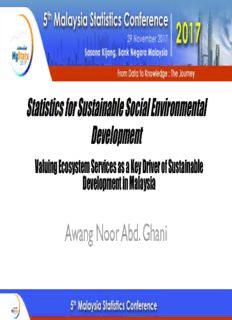
Awang Noor Abd. Ghani PDF
Preview Awang Noor Abd. Ghani
Statistics for Sustainable Social Environmental Development Valuing Ecosystem Services as a Key Driver of Sustainable Development in Malaysia Awang Noor Abd. Ghani 1. Introduction 2. Sustainable development 3. Ecosystem service (ES) 4. Valuation methods of ES 5. Valuation of ecosystem services in Malaysia 6. Challenges and actions needed 7. Conclusion 2 Introduction • Ecosystems generate a wide range of goods and services important for human well- being ecosystem services • Progress has been made in understanding how ecosystems provide services and how service provision translates into economic value • However, it is difficult to move from general findings about the benefits nature provides to people to credible, quantitative estimates of ecosystem service values • Explicit values of ecosystem services across landscapes that might inform policy and decision makers are still lacking Introduction • Sustainable development goals (SDGs) recognize the interconnections between social and ecological systems. • New interest in integrated social–ecological indicators • SDGs from sector specific goals towards more integrated social–ecological planning, tracking and reporting • Integrated SDG will require tracking and monitoring nature's contribution to human wellbeing and impacts of human activity on nature • Most common notion of nature-human interaction is through ecosystem services the benefits people derive from their interaction with ecosystems Need to value ecosystem services as a key enabler in achieving SDGs 4 Meaning of sustainable development Brundtland Report (1987) “Sustainable development is development that meets the needs of the present without compromising the ability of future generations to meet their own needs.” Three elements: Ecological, Social, Economic Sustainability is the foundation for today’s leading global framework for international cooperation – the 2030 Agenda for Sustainable Development and its Sustainable Development Goals (SDGs). 17 SDGs have been formulated 5 The 17 United Nations Sustainable Development Goals (SDGs) Sustainable Development Goal - Malaysia Goal 15: Live on Land Protect, restore and promote sustainable use of terrestrial ecosystems, sustainably manage forests, combat desertification, and halt and reverse land degradation and halt biodiversity loss 12 Targets 14 Indicators Target Indicator Target 15.9 Indicator 15.9.1: Progress towards By 2020, integrate ecosystem and national targets established in accordance biodiversity values into national and local with Aichi Biodiversity Target 2 of the planning, development processes, poverty Strategic Plan for Biodiversity 2011-2020 reduction strategies and accounts 7 National Biodiversity Action Plan 2016-2025 GOAL 2: WE HAVE SIGNIFICANTLY REDUCED THE DIRECT AND INDIRECT PRESSURES ON BIODIVERSITY Target 3: By 2025, biodiversity conservation has been mainstreamed into national development planning and sectoral policies and plans. Target 4: By 2025, our production forests, agriculture production and fisheries are managed and harvested sustainably. Target 5: By 2025, tourism is sustainably managed and promotes biodiversity conservation. 8 National Biodiversity Action Plan 2016-2025 Target 3: By 2025, biodiversity conservation has been mainstreamed into national development planning and sectoral policies and plans. Action 3.1: Embed biodiversity conservation into national and state development planning and sectoral policies and plans Action 3.2: Recognise the economic value of biodiversity and ecosystem services Action 3.3: Protect environmentally sensitive areas in statutory land use plans Action 3.4: Promote sustainable consumption and production 9 Action 3.2 • Establish a Natural Resource Accounting programme to monitor the values of natural resources, including biodiversity, to provide information that will permit the economic value of biodiversity to be taken properly into account in national planning. • Undertake a comprehensive valuation of biodiversity and ecosystem services including research on full-cost accounting of perverse subsidies and the internalizing externalities • Adopt appropriate mechanisms which may include payment for ecosystem services (PES) schemes such as public payment instruments, carbon trade and biodiversity offsets. 10
Description: